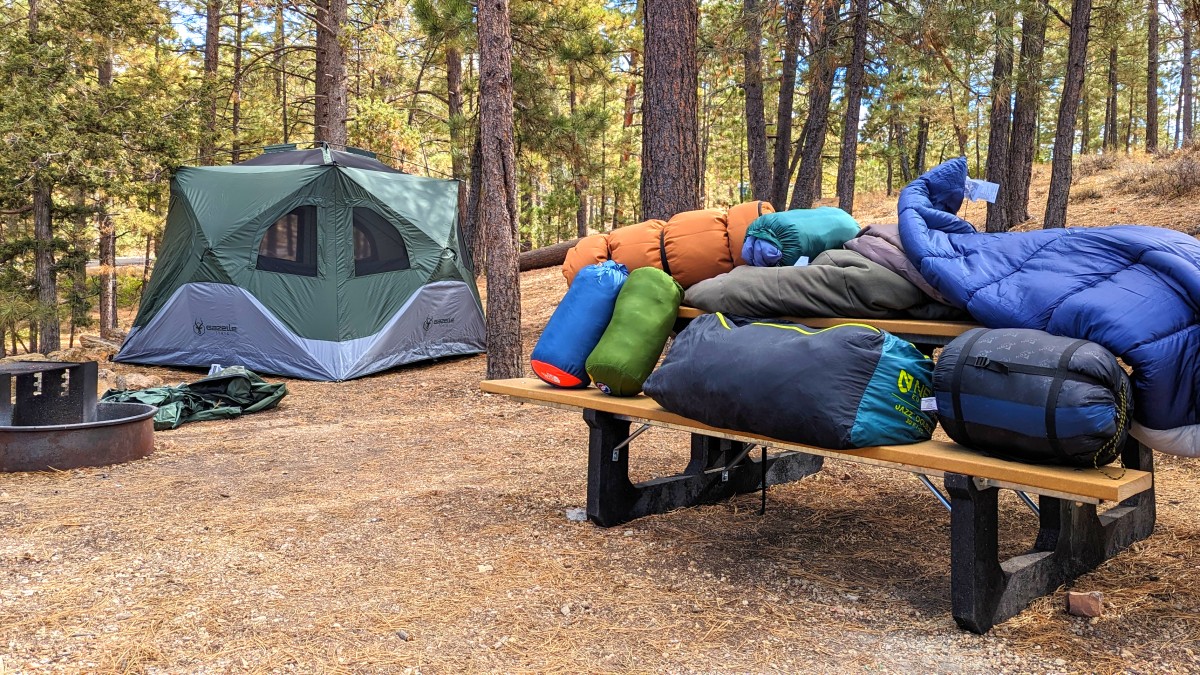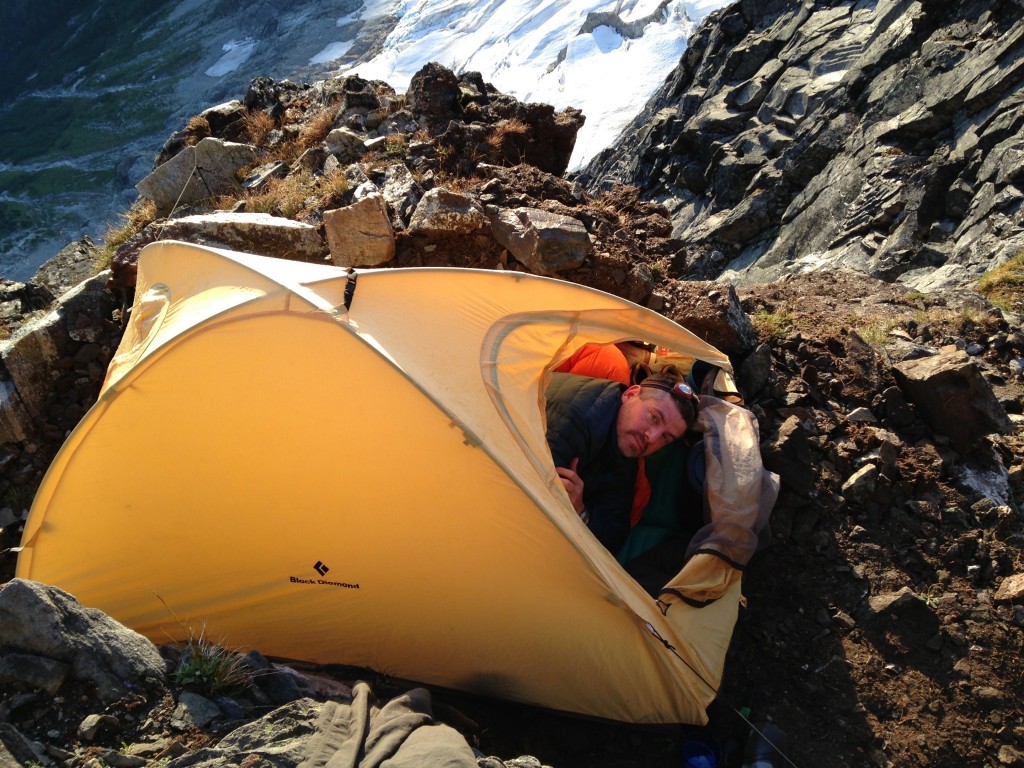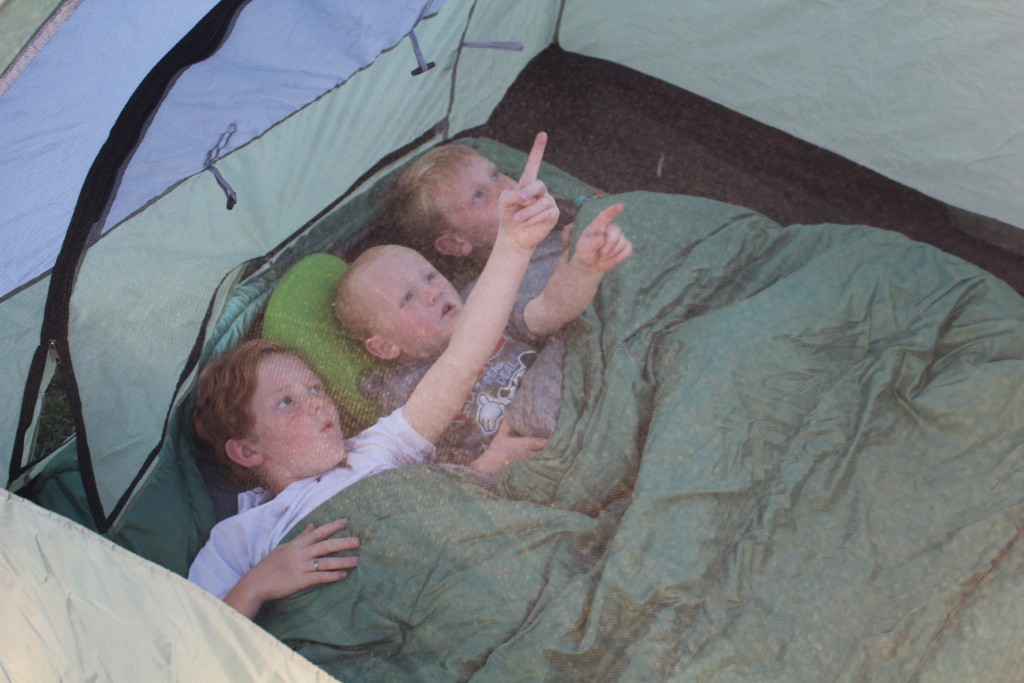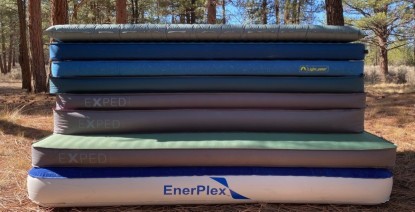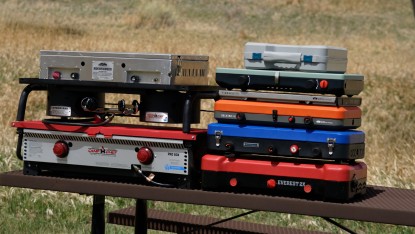In the confusing world of sleeping bags, picking the right one can be daunting. We're here to help you find the best bag for car or backyard camping in the great outdoors. On the most basic level, it needs to be warm enough for a good night's sleep and roomy and comfortable to accommodate the way you like to sleep.
Designed for Camping or Backpacking?
There are really just two main categories of sleeping bags. Down sleeping bags designed for backpacking that compress small enough and are light enough to carry around in a pack on your back for days, and (mostly) synthetic camping bags.
Related: Best Backpacking Sleeping Bag of 2024
Sleeping Bags for Camping
A camping bag is first and foremost designed to be warm and comfy to sleep in. They are inevitably bulkier and heavier than a backpacking bag, and most often are rectangular in shape. A camping bag is designed to be roomy and deliver a more pleasurable and better night's sleep. Few people describe their backpacking bag as cozy, but the top camping bags are downright snuggly. Camping bags use relatively inexpensive synthetic fibers for insulation and more durable fabrics, which also makes them much heavier and bulkier than a down sleeping bag.
The bottom line also differs, since top quality camping bags are sold for much lower prices. There are many 0-degree camping bags that sell for close to, or less than, $100.
Backpacking Sleeping Bags
Being the backcountry for days or weeks at a time has its limitations. The most significant of all are space and weight. Backpacking for several days requires lightweight, slim-fitting, down-insulated, mummy-shaped sleeping bags. The mummy-shaped design minimizes weight and, more importantly, creates a tighter shell around its user, creating more warmth because there is less air to warm. Down is the best insulator and is incredibly lightweight. Backpacking bags are expensive, starting around $170 and the top performing bags are in the $300 to $500 range.
Do I Need to Buy One?
Not necessarily. You can easily use a backpacking bag for campground camping. So if you've got one, don't hesitate to use it. While a camping bag may provide a more comfy and roomy sleeping experience, it is not a necessity. However the converse is not true: a camping bag is a poor choice for backpacking. They are simply too bulky and heavy.
Types of Camping Bags
The rest of the article will focus solely on sleeping bags for camping, and what to consider before making your purchase. There are several different types of camping bags, and each type has its list of pros and cons to consider that we will break down for you. The big differences in design approaches in a good sleeping bag are its shape, size, warmth rating, and type of insulation.
Shape
The image above shows a few of the different shapes of sleeping bags available. There are also a few crossover sleeping bags that can be used for both basic backpacking and car camping. However, for the sake of this article (and your sanity), we focus on two of the most basic shapes: rectangular bags and mummy bags.
Rectangular Bags
This is the most common shape for traditional sleeping bags. Rectangle designs allow maximum space to move around, resulting in maximum comfort. This is a time-tested design and is preferred by most car-camping enthusiasts. Traditional rectangle bags have rugged cotton exterior shells and cozy flannel linings. Weight and packed size are not as much of a concern when car camping, which allows many rectangular bags to be over-sized, thick, and plush. If zippers and sizes are compatible, two rectangle bags can be zipped together to create one large bag for two.
Below are some pros and cons of traditional, rectangular sleeping bags:Additionally, many rectangular bags are constructed entirely with man-made fibers like polyester. These fabrics allow the bags to be lighter weight and more compact when stored. Synthetic fabrics also are more water-resistant, silky and cooler.
Mummy Bags
Aptly named, these bags are more form-fitting. They generally have a hood designed to cover the head and are much narrower through the shoulder, midsection and foot box. There's a reason for the more constrictive design. Their shape allows the bag to more efficiently hold in body heat, giving them a higher warmth-to-weight ratio. In general, a mummy bag with a 20-degree rating can often be much lighter than a rectangle bag with the same score. The difference is the mummy bag uses less fabric to accomplish the same result. However, the tradeoff is less comfort and space. For this reason, many campground campers often select traditional rectangle bags.
Below are the positives and negatives of mummy bags.Other Shapes
In addition to mummy bags, there are a few semi-rectangular (or crossover/hybrid) bags on the market. These bags have more of a barrel shape and are designed to be a more general-purpose bag. They are primarily for car camping, but can also double as a backpacking bag for shorter trips. Typically, they have greater warmth-to-weight efficiency than rectangular bags but are roomier than traditional mummy bags.
Size: Is More Room Always Better?
Warmth is a very individual measurement. Every person has their tolerance for cold when the sun goes down, and the mountain air falls into the valleys. However, one general rule of thumb with sleeping bags is bigger isn't always better. A sleeping bag does not create warmth. It's only as warm as its ability to hold in body heat.
Larger bags, especially oversized rectangular bags, are comfortable because of the extra room they provide, but that increased volume leaves more area for body heat to warm. Think of your body like a wood-burning stove. The smaller the room where the stove sits in, the warmer the air will stay. However, trying to heat every room in the house with one central stove has its limits.
Larger bags have more interior air to be heated, and a smaller body just can't heat it all, leaving cold spots or an overall colder interior temperature. In warmer sleeping conditions, this doesn't create much of a problem, but that changes if nighttime temps are lower than 40 degrees.
All told you should consider your natural metabolism (do you normally sleep warm or cold), the size of your body, and the type of weather and climate where you usually camp. Additionally, it's important to consider the shelter you prefer. Tent camping and fifth-wheel camping have different warmth considerations.
Should I Consider a Double Bag?
Many rectangle bags can zip together to form one large bag. In terms of sheer warmth, this creates an ideal environment to share body heat. Sharing a double bag also has its drawbacks. The greatest of all being the inability to individualize warmth. In many cases, one sleeper is very comfortable, while the other is too warm.
Newer designs like the Kelty Tru.Comfort (above) offer one large, queen-sized bag with several layering options for individual warmth. Our tests revealed that these layers work well enough for a decent night's sleep. Additionally, a more traditional rectangle bag like the TETON Sports Polara, (below) can be zipped together, and come with several individual layering options as well.
In the end, using a double bag is strictly a personal preference. Some sleepers don't mind sharing the space, while others need a little alone time for better sleep. If you are interested in this type of sleeping system but are unsure, we recommend you consider going with two single bags that can be zipped together to form a double bag.
Warmth Ratings
What do the temperature ratings mean? If you've ever wondered, you're not alone. Does a rating of 0-degrees always equal a comfortable night's sleep when temps are 0 degrees? Generally speaking, no. Temperature ratings mean that the average person will not be comfortable at temperatures any lower than this rating. It also assumes the sleeper is wearing long underwear and is using a sleeping pad. For those reasons, we're almost always chilly well before the temperatures drop down to the rating.
The 20-Degree Rule
In addition to what you are wearing, metabolism plays a large factor in warmth and can vary greatly from person to person. So when selecting a camping sleeping bag, conventional wisdom recommends purchasing a product with a temperature rating about 20 degrees colder than the expected minimum overnight temperatures you plan to experience. For example, if you plan to mostly sleep in the 50s at night, pick a bag with a 30-degree rating — or wear your long underwear.
Other Warmth Ratings
Some technical sleeping bags (unlike the ones in this review) will have a set of temperature ratings based on the European Norm 13537 standardized test of sleeping bag warmth. Many manufacturers invest in having their bags' warmth tested by an approved lab in Europe, but not all. Real world testing gives us the most accurate idea of each bags' comfortable range of temperatures.
Types Of Insulation
There are two types of insulation used in traditional sleeping bags for camping: Synthetic insulation and down insulation. Whether rectangle, barrel or mummy-shaped, nearly all camping bags use some version of synthetic insulation. This is because it is cheaper and more plentiful, making the bags less expensive for a broader range of buyers. Many mummy bags use down, making them more appropriate for backpacking.
Synthetic Insulation
Camping bags keep you warm by layering batts (or blankets) of polyester fibers to hold in the warmth your body creates. The thickness of the insulation is referred to as the loft. Regardless of the type of insulation, the greater the loft, or thickness, the warmer it will keep you. In other words, the more insulation you stack up inside the bags inner lining and outer shell, the warmer and heavier it will be. Here are the pros and cons of synthetic insulation:
Pros- Inexpensive
- Easier to launder
- Dries much faster
- Durable (think teenagers or young kids)
- Insulates better than down when wet
- Hypoallergenic
- Heavier
- Less effective insulator than down
- Bulkier/less compressible when packed
- Man-made
Down Insulation
It's rare for a regular camping bag to use goose down for its insulation; however, there are a few bags that do. Down insulation is still unsurpassed for its ability to trap heat. Most synthetic insulation fibers are manufacturer's attempts to mimic down's incredible abilities to create warmth. Basically, everything synthetic insulation is, down is not, and vice versa. This creates many pros and cons:
Pros- Unmatched ability to insulate
- Very lightweight
- More comfortable feel
- Very compressible (packs very small)
- Does not insulate when wet
- Expensive
- Comes from animals
- Allergenic to some people
Weight and Packed Size
Synthetic insulation is both bulky and heavy relative to down; that's partially why products built for car camping are large when packed for transport. Some of the models we tested weigh more than 10 pounds, but who cares? When car camping, you rarely carry your kit more than a couple of hundred feet, and being cozy and comfortable is worth the extra weight and bulkiness. A few of the camping bags in our review are just small and light enough to carry on brief backpacking trips. Synthetic insulation can be a good choice for a backpacking bag if you're almost certainly going to get wet, but will always be heavier and less compressible than a similarly warm down-insulated product.
Features and Additional Considerations
Here are some additional considerations that will help you choose a bag that will keep you a happy camper.
Ease of Cleaning
We'd love to say that you can just throw all of these bags into the wash at home. That's not often the case. Many of these require the larger, front-loading washers at laundromats or require laborious hand washing. Something to consider.
Interior Storage Pocket
Need easy access to your headlamp, Chapstick (careful in bear country), or cell phone at all hours? You'll want to look for integrated storage pockets.
Shoulder Baffle
One downside of a rectangular bag is that a lot of heat can escape from the opening. Bags with shoulder baffles reduce this effect by narrowing the opening. Those with drawstrings to pull the baffle tight are even better.
Zipper Baffle or Draft Tube
Look for a bag with a substantial baffle running the full length of the zipper to keep drafts outside where they belong.
Full-Length Zipper
A full-length zipper lets you open your sleeping bag up entirely to use as a comforter or lounge blanket. We're all for enhanced versatility. Other zipper considerations include:
- Velcro Zipper Closure - It's easy to toss and turn your way to an unzipped zipper, and an unpleasant draft. A little Velcro tab goes a long way to combat that situation.
- Two Way Zipper — A bag that opens at either end gives you more options to optimize your comfort level.
- Zipper Quality — A broken zipper is a common way to end an item's lifespan. Make sure yours unzips and zips easily.
A Few Last Things to Consider
- Does the bag easily fit into its stuff sack? Nothing is more crazy-making than wrestling with a sleeping bag for half an hour.
- What kind of warranty does the bag have? Many companies offer a warranty against manufacturer defects that lasts the reasonable lifetime of the product. That can come in handy.
- Where is the bag made? We like to support companies that support their workers and the environment.
Conclusion
There are many sleeping bags to choose from, and even more bells and whistles offered by each brand. However, of all the factors to consider, two are the most important: Will the bag you want to keep you warm, and is the bag you want going to be comfortable? By at least getting these two things correct, you are well on your way to good night's rest in the outdoors.

